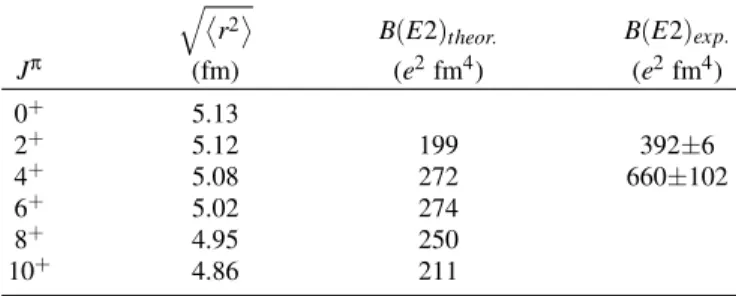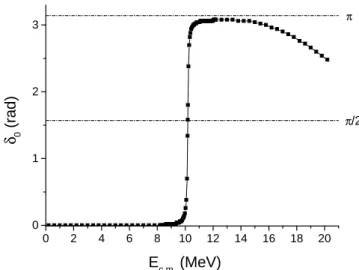826 Brazilian Journal of Physics, vol. 35, no. 3B, September, 2005
The Alpha-Cluster Bands in
94
Mo
Marco Antonio de Souza and H. Miyake
Instituto de F´ısica, Universidade de S˜ao Paulo, CP 66318, 05315-970, S˜ao Paulo, SP, Brazil
Received on 6 May, 2005
The94Mo nucleus is treated as anα-cluster interacting with an inert core through a phenomenological local
potential. The properties of the ground state band of theα+90Zr system, such as the energy levels, intercluster
rms radii andB(E2)transition strengths were calculated. These results are compared with previous references and available experimental data. Some predictions were made concerning the negative parity band and the excited positive parity band.
Theα-cluster structure is an important feature for light nu-clei. Theα-cluster model has been successful in reproducing the behaviour of the energy spacings, electromagnetic proper-ties,α-widths andα-nucleus elastic scattering data around the double shell closures such as16O and40Ca [1–3]. The search forα-cluster states in heavier nuclei is the natural sequence of investigations. Recent studies [4–6] indicate the persistence ofαclustering in theA=90 mass region.
According to the α-cluster model, the total nucleus is vi-ewed as anα-particle orbiting an inert core. In the case where both constituents have spin zero, no complications arise from the spin-orbit coupling. The90Zr medium-heavy nucleus pre-sents a closed shell for neutrons and filled subshells for pro-tons up to 2p1/2and may be considered approximately as an inert core. In this way the proposed model is employed to the 94Mo nucleus, which is regarded as anα+90Zr system. The interaction was described through a local phenomenolo-gical potentialV(r) =VC(r) +VN(r)containing the nuclear and Coulomb terms. The Coulomb potentialVC(r)is taken to be that of a pointα-particle interacting with an uniformly charged spherical core of radiusR=5.793 fm. The interclus-ter nuclear potential
VN(r) =−V0 (
b 1+exp¡r−R
a ¢+
1−b £
1+exp¡r3−aR¢¤3 )
proposed by Buck, Merchant and Perez [4] was used, where V0=220 MeV,a=0.65 fm,b=0.3 andRis the radius used in the Coulomb potential. The parametersV0,aandbhave been fitted to reproduce satisfactorily the experimental excitation energies of the ground state bands of20Ne, 44Ti,94Mo and 212Po, as well as the experimentalα-decay half-lives for se-veral even-even heavy nuclei, whileRis fitted for94Mo. The form ofVN(r)has been adopted because of its similarity to the real parts of the optical potentials determined fromα-16O and α-40Ca elastic scattering [4].
Theα-90Zr system can be solved numerically to obtain the properties of the bound, quasibound and resonant states. The energy eigenvalues yield the levels of the spectrum and the associated wave functions are used to calculate other nuclear properties. The nucleons of the α-cluster must lie in shell-model orbitals above those already occupied by the core nu-cleons, according to the Pauli principle. This restriction is
TABLE I: Theoretical and experimental values for theB(E2) tran-sition rates and theoretical values for the intercluster rms radii con-cerning theα-90Zr ground state band (G=16). The experimental values are from Ref. [11].
q
r2®
B(E2)theor. B(E2)exp.
Jπ (fm) (e2fm4) (e2fm4)
0+ 5.13
2+ 5.12 199 392±6
4+ 5.08 272 660±102
6+ 5.02 274
8+ 4.95 250
10+ 4.86 211
defined by the quantum number
G=2N+L,
whereN is the number of internal nodes in the radial wave function andLis the orbital angular momentum. Gis a glo-bal quantum number which identifies a band of levels. In the case of theα-90Zr system we have G≥16, where G=16 corresponds to the ground state band. This value is obtained from the Wildermuth condition [7] and yields an appropriate description of theα-90Zr ground state band [4, 5].
The energy levels of the ground state band (Fig. 1) and the respective radial wave functions were obtained solving direc-tly the Schr¨odinger equation for the system. These functions were used to determine the associatedB(E2)transition rates and the intercluster rms radii for this band (Table I). The calculated ground state band shows a quasirotational spec-trum and it is in total agreement with the theoretical values of Ref. [4], where the spectrum is obtained by using the Bohr-Sommerfeld quantization rule. The calculated energies give a satisfactory description of the experimental spectrum, if one takes into account that the parameters of this local potential are notLdependent or energy dependent.
Marco Antonio de Souza and H. Miyake 827
-3 -2 -1 0 1 2
+
+ + +
+
+ +
+ +
+
+
10
8
6
4
2
0
+
10
8
6
4
2
0
Calculated Experim.
E
(
M
e
V
)
FIG. 1: Comparison of the calculated and measuredα-90Zr energies
for the ground state band (G=16). The values are given with respect to the theoreticalα-90Zr threshold. The experimental values are from Ref. [9].
with calculations of Ohkubo [5]. The calculatedB(E2) tran-sition strengths have the same magnitude of the experimental values. These results may be considered satisfactory, once the B(E2)values are calculated without any effective charge.
The degree of shell-model-like character in the ground state band was estimated through the expansion of the correspon-ding radial wave functions in the harmonic oscillator basis with the parameterν=µω/2~, whereµis the reduced mass
of the system andωis given by~ω=41A−1/3MeV. This ex-pansion shows a large overlap between these radial wave func-tions and the respective harmonic oscillator wave funcfunc-tions with similar quantum numbersGandL(the overlap increases from 89.1% for the 0+state to 95.0% for the 10+state). Such result indicates that the ground band states present a shell-model trend.
The intercluster potentialV(r)has also been used to make some predictions about higher lying bands which are above the α+90Zr threshold. The functionsδ
L(E)forL=0, 1, 3 and 5 were calculated, whereδL is the scattering phase shift for a givenL(see Figs. 2 and 3). The totalα-widthΓαcan be extracted from the functionsδL(E)by [3, 8]
Γα= 2
(dδL/dE)|E=ER
,
whereER is the resonance energy for which the phase shift crosses π/2 up to a constant multiple ofπ. The vicinity of each resonance was located previously by using the bound state approximation and the resonance energies were determi-ned through the functionsδL(E). In the numerical calculation of these functions, an energy step∆E=0.4 MeV was applied for energies far from the resonances; however, for energies in the vicinity of each resonance,∆E must be reduced in orders of magnitude to provide an accurate value fordδL/dEinER.
The calculated resonance energies and total α-widths are
0 2 4 6 8 10 12 14 16 18 20
0 1 2
3 π
π/2 δ0
(
ra
d
)
Ec.m. (MeV)
FIG. 2: Scattering phase shifts calculated withL=0 for theα-90Zr system. The resonance energy for whichδ0=π/2 corresponds to
the 0+state of theG=18 band.
5.1681531 5.1681532 5.1681533 5.1681534 5.1681535 0.0
0.4 0.8 1.2 1.6 2.0 2.4 2.8 3.2
(b) (a)
π/2
π
δ1
(
ra
d
)
Ec.m. (MeV)
0 2 4 6 8 10 12 14 16 18 20 0
1 2 3 4 5
π/2 3π/2
π
δ1
(
ra
d
)
FIG. 3: Scattering phase shifts calculated withL=1 for theα-90Zr system. The graph (a) shows the phase shifts calculated between 0 and 21 MeV. The graph (b) shows the phase shifts calculated in the vicinity of the resonance energy for whichδ1=π/2, corresponding
828 Brazilian Journal of Physics, vol. 35, no. 3B, September, 2005
TABLE II: Theoretical resonance energies and respective total α -widths for some states of higher lying bands of theα-90Zr system. The energies are given with respect to the theoretical α+90Zr
th-reshold.
ER Γα
Jπ G (MeV) (10−3eV)
1− 17 5.17 3.1
3− 17 5.66 13.3
5− 17 6.45 53
0+ 18 10.18 8.7×107
given in Table II. The values refer to the first members of the negative parity band (1−, 3−and 5−) and the first member of the excited positive parity band (0+). The very small widths of the states of the negative parity band indicate that the proper-ties of such states may be investigated within the bound state approximation. Therefore, it is suggested that the adequate treatment for theG=17 band is analogous to the treatment given for the negative parity band of theα-40Ca system [3].
The level 0+of theG=18 band lies at about 1.5 MeV below the Coulomb barrier, resulting in a larger width (87 keV). This indicates that theG=18 band presents a typical resonance fe-ature. Higher spin members of theG=17 andG=18 bands are expected above the calculated levels, as in lighterα-core systems.
The present calculations confirm that theα-cluster model is still an important tool for the spectroscopic analysis of94Mo. The procedures described in this work may provide other pre-dictions concerning the higher spin states of theG=16, 17 and 18 bands. More experimental data are necessary to verify our calculated energy levels for the negative parity band and the excited positive parity band.
Acknowledgments
The authors thank the members of the Nuclear Spectros-copy with Light Ions Group of IFUSP for the useful discussi-ons. This work was partially supported by CAPES.
[1] B. Buck, C.B. Dover and J.P. Vary, Phys. Rev. C 11, 1803 (1975).
[2] F. Michel, G. Reidemeister and S. Ohkubo, Phys. Rev. Lett.57, 1215 (1986).
[3] F. Michel, G. Reidemeister and S. Ohkubo, Phys. Rev. C37, 292 (1988).
[4] B. Buck, A.C. Merchant and S.M. Perez, Phys. Rev. C51, 559 (1995).
[5] S. Ohkubo, Phys. Rev. Lett.74, 2176 (1995).
[6] F. Michel, G. Reidemeister and S. Ohkubo, Phys. Rev. C61,
041601 (2000).
[7] K. Wildermuth and Y.C. Tang,A Unified Theory of the Nucleus
(Academic Press, New York, 1977).
[8] A. Arima and S. Yoshida, Nucl. Phys.A219, 475 (1974). [9] B. Kharrajaet al., Phys. Rev. C57, 2903 (1998).
[10] R.C. Barrett and D.F. Jackson, Nuclear Sizes and Structure


